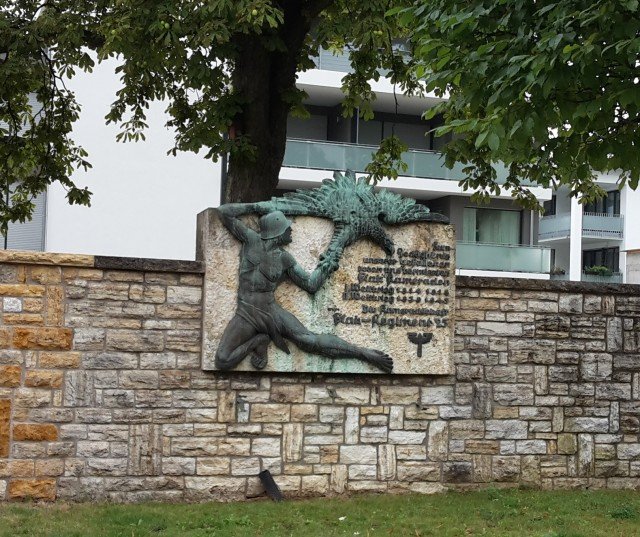
USAG Stuttgart Public Affairs Office
The City of Ludwigsburg and the Military Historical Association Ludwigsburg will host a ceremony to unveil a commemorative plaque Sept. 13 from 11 a.m. to 1 p.m. for Soldiers of the U. S. Army who served on Flakkaserne from 1950 to 1991.
History of Flakkaserne
The name Flakkaserne includes the German abbreviation “Flak” which is short for “Flugabwehrkanone”, anti-aircraft cannon. The Kaserne was built for the 25th Flak Regiment between 1936 and 1938, in the Ossweil district of Ludwigsburg located on the outskirts of the city.
Flakkaserne didn’t consist of only military structures—there were also housing facilities for officers and non-commissioned officers. The buildings had one or two stories with hipped-end or gabled roofs. The Kaserne was divided into three main areas:
- The entrance on the west side with guard house, officers’ club, officer apartments, and headquarters buildings;
- Neighboring U-shaped troop barracks;
- Two dining facilities, gym, and medical center.
Most of the buildings were clustered around the technical and workshop areas as well as the many football fields and the main parade ground.
In 1939, the 25th Flak Regiment deployed from the Kaserne to war. Throughout the following years, the Kaserne was occupied by replacement troops, training and logistics units, as well as a military court.
Following World War II, Flakkaserne housed an Internment Camp, IC 74, for former officials of the National Socialist regime during denazification.
In 1948, the Kaserne was utilized as a camp for Germans driven from their homes in Eastern Europe and other refugees.
From 1950 to 1991, the U.S. Army was stationed on the Kaserne. The Kaserne’s main resident was the 4thTransportation Battalion until its deployment to the Gulf War in 1991 and later redeployed back to the U.S.
In 1991, Flakkaserne was the first Kaserne in Ludwigsburg vacated by the U.S. Army and, under the ownership of the German federal government, remained empty. In 2007, the City of Ludwigsburg acquired the Kaserne from the government.
The majority of buildings were subsequently demolished, only trees and several buildings under historical preservation were kept: the Officer’s Club, the gym as well as the main gate with its guard house, and a portion of the Kaserne wall with its memorials. Between 2007 and 2009, the residential area “Hartenecker Hoehe” boasting apartment and row houses, duplexes and single-family homes, was built there. Today, 2,000 residents call this area home.
In 2009, a new street was dedicated to a Ludwigsburg resident, Lt. Col. Cesar von Hofacker, who was a member of the military resistance against Adolf Hitler July 20, 1944. Like his cousin, Col. Claus Schenck Graf von Stauffenberg, von Hofacker was executed after the attempt failed.
The relationship between the Soldiers stationed on Flakkaserne and Ludwigsburg residents was always friendly. In 1954, a German-American Club was founded, with the goal of promoting and maintaining contact between Germans and Americans. During the annual German-American Fest, local music groups used to perform and representatives of the city were also invited to attend change of command and other ceremonies.
A relationship also developed between the German veterans of the 25th Flak Regiment and Soldiers of the U.S. 4thTransportation Battalion. In 1959, veterans of the 25th Flak Regiment along with the American military dedicated a memorial for German Flak-Soldiers who fell during both world wars at the Kaserne’s main gate. The memorial depicts a warrior with steel helmet and sword defending against an attacking eagle. In 1984, the memorial was expanded with the additional memorial tablet in commemoration of Flakkaserne’s 50th anniversary.
The ceremony will be held at Flackkaserne Ludwigsburg, Caesar-von-Hofackeranlage 1, 71640 Ludwigsburg. Stuttgart military community members are invited to attend. Attire is dress uniform and business dress or pants suit. Entrance to the Garrison Museum and the Ludwigsburg Palace is also free Sept. 13. The “Garnisonmuseum,” or Garrison Museum, in Ludwigsburg is a military history museum. The memorial tablet is part of a small exhibit at the Garrison Museum.
